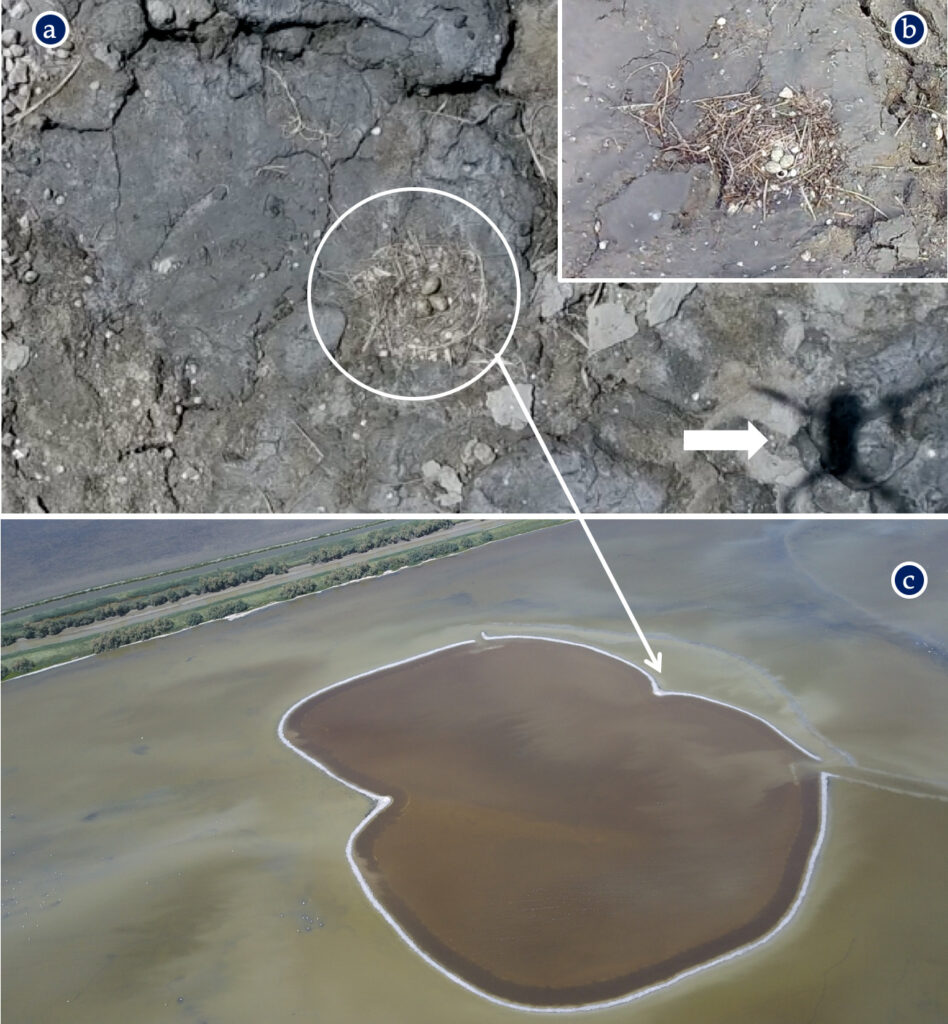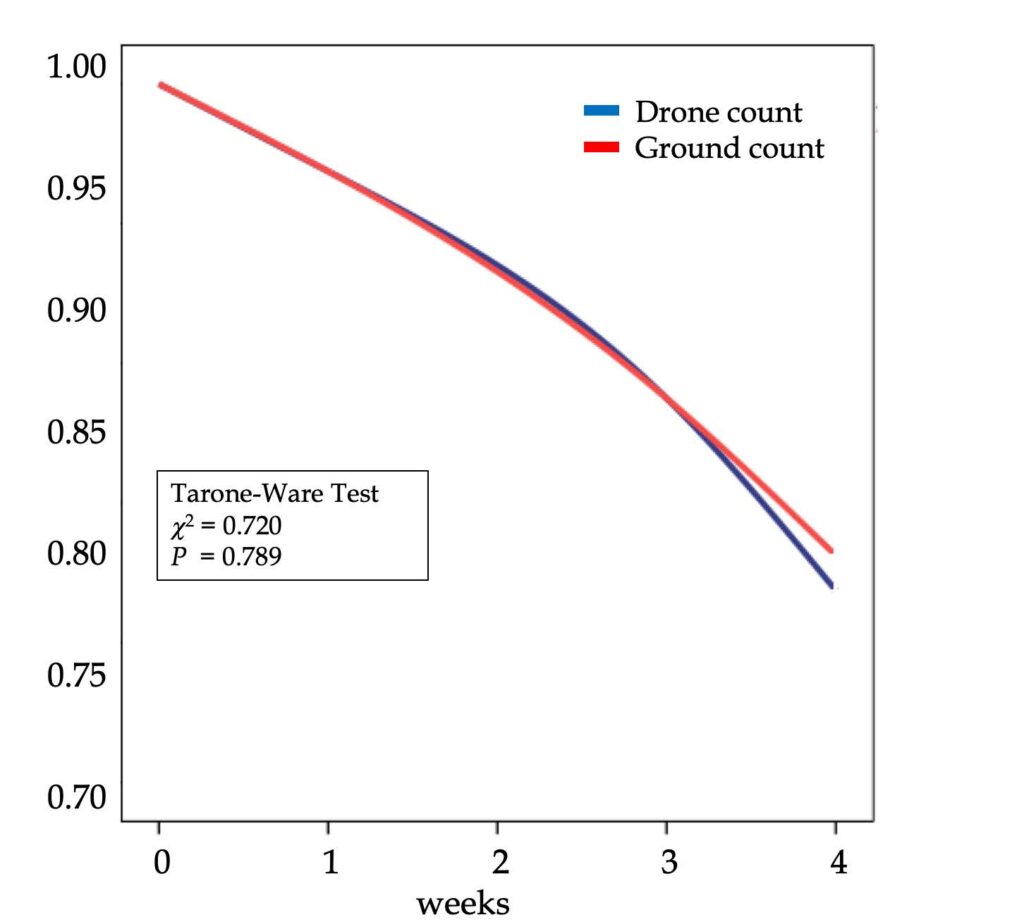Stima del successo riproduttivo dell’Avocetta con l’utilizzo del drone – Uno studio pilota
Nesting colonial waterbirds are particularly vulnerable to human intrusion, even when intruders are conservationists. On the other hand, measuring productivity of birds is a necessary step for efforts in conservation. Therefore, it is crucial to find ways to minimize the impact of investigator disturbance, with particular reference to the most intrusive methods (Carney & Sydeman, 1999; Champagnon et al., 2019).
In recent years, drones have received considerable attention as a powerful tool for biological field research, in view of their ability to mitigate disturbance to birds (Hodgson & Koh, 2016).
The Pied Avocet (Recurvirostra avosetta Linnaeus, 1758) is a medium-size wader, which breeds in flat open areas on shallow saline or brackish wetlands with islands of bare sand, clay or mud (BirdLife International, 2019). Traditional ground counts of nesting avocets involve field biologists entering colonies, searching for nests (Valle et al., 1994; Cuervo, 2004).
The present study aims to assess effectiveness, safety for birds and managerial efficiency of drone monitoring of breeding success, as opposed to traditional census methods, on a colony of Pied Avocets.
Fieldwork was performed throughout the breeding seasons 2019, in a fish farm of the Po Delta (NE Italy; 44°57’ N, 12°31’ E), through five weekly surveys (0 to 28 days from laying). We studied a colony of 44 pairs, located on a hearth artificial island (1.2 m wide and 0.2 m above the water level, with an approximate diameter of 550 m; Fig. 1). Drone method: flying 70 m above ground level (AGL), the drone (DJI Mavic Pro) reached the vertical point of the colony, where nest attendance was assessed, and was slowly driven to an altitude of 3 m AGL to fly over the colony at a speed of 15 km/h. Counts of clutches (and eggs per clutch) were then performed on a personal computer (Fig. 1; Valle & Scarton, 2019). Traditional method: on each visit, one researcher walked through the colony mapping all nest and recording numbers of eggs and chicks. Each ground count followed the associated drone count within 30 minutes. The activities of this study complied with the current laws in Italy. The amount of disturbance during each flight, as well as in each ground survey, was calculated as a function of 1) the number of clutches/eggs predated/deserted as a consequence of census activities; 2) the time spent away from nests by incubating birds. Costs were measured and was limited to human labor costs (60 euro/h). We used the kappa test to test the hypothesis that agreement between the two methods was greater than chance alone (Cohen, 1977). We analysed survival functions using Kaplan-Meier estimation (Marubini & Valsecchi, 1995).
There were no significant differences in the number of laid or hatched eggs per nest between the two methods: 3.6±0.6 versus 3.6±0.6 and 3.14±1.36 versus 3.18±1.37 (t-test carried out on the variable square root transformed; P>0.05 for both). The average coefficient of agreement between methods was “nearly perfect” (kappa = 1.000 and 0.922; P=0.000 for both). Six nests (13.6%) did not hatch any chicks. Overall, 22 eggs were lost. No eggs were predated. The most common cause of egg loss was flooding (82%). Flooded nests were easily classified by both methods, since they appeared heavily damaged and eggs were very frequently washed away from the cups. On the contrary, both drone and ground surveys misclassified as “active” respectively two and one deserted clutches. Two addled eggs and one chick that died in the process of hatching were not discerned by drone surveys, being correctly categorised only at the end of the 4-week period during ground counts. Two more eggs, which fell in a crack close to the nest, were misclassified as “hatched” by drone surveys. According to the above results, the timing of failure was similar between the two methods (Tarone-Ware test; χ2=0.720; P=0.789; Fig. 2).
Time spent far from nests by alarming birds was greater during ground counts than with drone surveys: 4.0±0.8 min versus 1.2±0.1 min (t test performed on the square-root-transformed variable; P=0.000; N=5). Neither nest desertions, nor clutch predations were observed during drone surveys.
The overall time taken to complete the whole monitoring (5 visits) was far shorter with the drone approach than with the traditional counts (17 versus 60 min), but 19 more min were needed for post-processing work for the drone approach.
However, overall drone count lengths kept being shorter than ground counts (64 versus 135 min), due to far longer times needed to reach (and leave) the colony by the ground method (75 versus 28 min). This time corresponds to an expenditure of 64 € versus 135 € for the drone versus ground approach. These costs represent a saving of 71 € (-53%) in favour of the former.
The major findings of our study are as follows: 1) there are no significant differences in hatching success estimation in avocets between drone and observer counts, 2) using drones can save time and money compared to traditional ground census approaches, and 3) apart from their advantages, drones are also associated with a reduced disturbance response among avocets.
Our study extends previous literature in demonstrating that drones can provide detailed data on hatching success as reported in Hooded Crow (Corvus cornix; Weissensteiner et al. 2015), Black-headed Gull (Chroicocephalus ridibundus; Sardà-Palomera et al., 2017), and three duck species (Mallard Anas platyrhynchos), Common Teal (Anas crecca), and Common Goldeneye (Bucephala clangula) (Pöysä et al., 2018). To our knowledge, our results are the first comparative data on drone versus ground approaches in the estimation of hatching success of a wader species.
The reduction of disturbance with drone use, could be particularly useful in the first period of colonies settlement, when adults are most sensible to the disturbance caused by investigators, and thus most prone to abandon colony sites (Nisbet, 2000). As an aside, we mention that mean flight initiation distance in response to drone intrusion in our study (49+14 m; range 20 – 80) was not statistically different from those due to pedestrian (48+16 m; range 20 – 92) or boat (56+24 m; 19 – 95) disturbance (Kruskal-Wallis Anova; P=0.726) reported by Scarton (2018).
Finally, it should be noticed the importance of the reduction of costs of surveying colonies with the drone use in a period of budget downsizing like the one conservation scientist are facing nowadays.
The main limitation of our study resides in the selection of a small colony, in the absence of associated species. Preliminary observations in our study area, showed a critically low accuracy of drone counts of avocets breeding at high densities along with other Charadriiformes species (pers. obs.). On drone intrusion, birds from different species incubating at high densities usually take off together, because the alarm calls by birds close to the latter (Valle & Scarton, in press), in particular by Eurasian Oystercatcher Haematopus ostralegus, when


present (Valle & Scarton, 2019). A similar “group size effect” in avocets was recently reported for pedestrian intruders (Scarton, 2018).
In conclusion, a drone-based approach is as good as ground surveys for measuring hatching success of avocets nesting in small, single-species colonies and represents an optimal alternative method for field researchers.
References
BirdLife International (2019) – BirdLife International (2019) Species factsheet: Recurvirostra avosetta. Downloaded from http://www.birdlife.org on 22/10/2019.
Carney K. M., Sydeman W. J. (1999) – A review of human disturbance effects on nesting colonial waterbirds. Waterbirds, 22: 68-79.
Champagnon J, Carré H, Gili L. (2019) Effects of research disturbance on nest survival in a mixed colony of waterbirds. PeerJ.7:e7844. Published 2019 Oct 11. doi:10.7717/peerj.7844
Cohen J. (1977) – Statistical power analysis for the behavioural sciences. Academic Press, NY, USA.
Cuervo J. J. (2004) – Nest-site selection and characteristics in a mixed- species colony of Avocets Recurvirostra avosetta and Black-winged Stilts Himantopus himantopus. Bird Study, 51, 20-24.
Hodgson J. C., Koh L. P. (2016) – Best practice for minimising unmanned aerial vehicle disturbance to wildlife in biological field research. Current Biology, 26: 404-405.
Marubini E., Valsecchi M. G. (1995) – Estimation of survival probabilities. In: Analysing Survival Data from Clinical Trials and Observational Studies. John Wiley & Sons, New York, USA.
Nisbet I. C. T. (2000) – Disturbance, Habituation, and Management of Waterbird Colonies. Waterbirds, 23: 312-332.
Pöysä, H., Kotilainen J., Väänänen V. M., Kunnasrant M. A. (2018) – Estimating production in ducks: a comparison between ground surveys and unmanned aircraft surveys. European Journal of Wildlife Research, 64: 74.
Sardà-Palomera, F., Bota G., Padilla N., Brotons L., Sardà F. (2017) – Unmanned aircraft systems to unravel spatial and temporal factors affecting dynamics of colony formation and nesting success in birds. Journal of Avian Biology, 48: 1273-1280.
Scarton F. (2018) – Flight initiation distances in relation to pedestrian and boat disturbance in five species of waders breeding in a Mediterranean lagoon. Revue d’Ecologie (Terre et Vie), 73: 375-384.
Valle R.G., Scarton F. (In press) – Drones improve effectiveness and reduce disturbance of censusing Redshanks Tringa totanus breeding on salt marshes. Ardea.
Valle R. G., Scarton F. (2019) – Effectiveness, efficiency, and safety of censusing Eurasian Oystercatchers Haematopus ostralegus by unmanned aircraft. Marine Ornithology, 47: 87-93.
Valle R., Scarton F., Borella S., Tiloca G. (1994) – Nidificazioni di Avocetta (Recurvirostra avosetta) nella laguna di Venezia. Lavori Soc. Ven. Sci. Nat., 19: 99-102.
Weissensteiner M. H., Poelstra J. W., Wolf J. B. W. (2015) – Low-budget ready-to-fly unmanned aerial vehicles: an effective tool for evaluating the nesting status of canopybreeding bird species. Journal of Avian Biology 46: 425-430.

